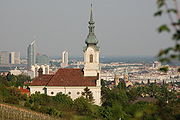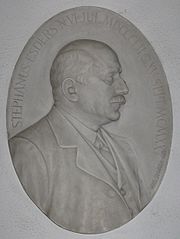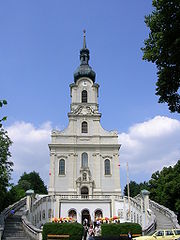
Kaasgrabenkirche
Encyclopedia

Grinzing
Grinzing was an independent municipality until 1892 and is today a part of Döbling, the 19th district of Vienna.- Geography :- Location :...
in the 19th district of Vienna
Vienna
Vienna is the capital and largest city of the Republic of Austria and one of the nine states of Austria. Vienna is Austria's primary city, with a population of about 1.723 million , and is by far the largest city in Austria, as well as its cultural, economic, and political centre...
, Döbling
Döbling
Döbling is the 19th District in the city of Vienna, Austria . It is located on the north end from the central districts, north of the districts Alsergrund and Währing...
. The church has been managed since 1903 by the order of the Oblates of St. Francis de Sales
Oblates of St. Francis de Sales
The Oblates of St. Francis de Sales are a congregation of Roman Catholic priests and brothers who base their spirituality on the teachings of St. Francis de Sales and St. Jane de Chantal. The Oblates of St. Francis de Sales (Latin: Oblati Sancti Francisci Salesii, O.S.F.S.) are a congregation of...
and is equally the seat of the branch of the order covering Austria
Austria
Austria , officially the Republic of Austria , is a landlocked country of roughly 8.4 million people in Central Europe. It is bordered by the Czech Republic and Germany to the north, Slovakia and Hungary to the east, Slovenia and Italy to the south, and Switzerland and Liechtenstein to the...
and Southern Germany
Germany
Germany , officially the Federal Republic of Germany , is a federal parliamentary republic in Europe. The country consists of 16 states while the capital and largest city is Berlin. Germany covers an area of 357,021 km2 and has a largely temperate seasonal climate...
. It has had the status of a parish church
Parish church
A parish church , in Christianity, is the church which acts as the religious centre of a parish, the basic administrative unit of episcopal churches....
since 1939.
The name Kaasgrabenkirche hearkens back to an old name for the local area, which probably indicates the presence of water (mineral springs) that were rich in iron and sulphur. The smell and colour of this water resembled whey
Whey
Whey or Milk Serum is the liquid remaining after milk has been curdled and strained. It is a by-product of the manufacture of cheese or casein and has several commercial uses. Sweet whey is manufactured during the making of rennet types of hard cheese like cheddar or Swiss cheese...
, which is sometimes referred to as Käsewasser (literally, cheese water) in German
German language
German is a West Germanic language, related to and classified alongside English and Dutch. With an estimated 90 – 98 million native speakers, German is one of the world's major languages and is the most widely-spoken first language in the European Union....
. References survive from 1280 to Chezwazzeresgraben and from 1331 to Cheswassergraben.
History

Battle of Vienna
The Battle of Vienna took place on 11 and 12 September 1683 after Vienna had been besieged by the Ottoman Empire for two months...
in 1683. According to the legend, a young woman was scavenging for berries with her child when she was surprised by Turkish soldiers. She hid behind an elderberry bush. The soldiers followed her footprints to the bush but, seeing swallow
Swallow
The swallows and martins are a group of passerine birds in the family Hirundinidae which are characterised by their adaptation to aerial feeding...
s nesting in the branches, assumed that no-one could be hiding there. The woman donated a Bildstock
Bildstock
A wayside shrine, is a religious image, usually in some sort of small shelter, placed by a road or pathway, sometimes in a settlement or at a crossroads, but often in the middle of an empty stretch of country road, or at the top of a hill or mountain. They have been a feature of many cultures,...
dedicated to Mary as a sign of her gratitude. There is however no evidence that such a shrine ever existed.
The land on which the church now stands belonged in the 19th century to a Mr. Kothbauer, an industrial magnate who owned sand pits in the Kaasgraben area. He also owned a house in the 7th district, Neubau
Neubau
Neubau is the seventh district of Vienna . It is located near the center of Vienna and was established as a district in 1850, but borders changed later...
, near the St.-Ulrichskirche (St. Ulrich’s
Ulrich of Augsburg
Saint Ulrich , sometimes spelled Uodalric or Odalrici, was Bishop of Augsburg and a leader of the Roman Catholic Church in Germany. He was the first saint to be canonized.-Family:...
Church). When his house was torn down, he relocated a much-revered Pietà
Pietà
The Pietà is a subject in Christian art depicting the Virgin Mary cradling the dead body of Jesus, most often found in sculpture. As such, it is a particular form of the Lamentation of Christ, a scene from the Passion of Christ found in cycles of the Life of Christ...
statue from its courtyard to the site of the Kaasgrabenkirche, and, to mark the 200th anniversary of the young woman’s rescue from the Turkish soldiers in the legend, built a small chapel over the statue in 1883. Kothbauer also opened a Heuriger next to the chapel. Sellers of devotional objects and musicians who performed in the restaurant were quickly attracted to the site. Kothbauer added swings and a shooting gallery, so that the “Schwalbenkapelle” (“Swallows’ Chapel”, as it was known, in reference to the legend) quickly became famous as the “Kapelle mit Heurigenschank” (“The chapel with the bar”). Given Kothbauer’s fine business sense, it has even been suggested that he invented the legend and had it reported in the newspapers. Kothbauer’s success was such that many Heurige in Sievering
Sievering
Sievering is a suburb of Vienna and part of Döbling, the 19th district of Vienna. Sievering was created in 1892 out of the two erstwhile independent suburbs Untersievering and Obersievering. These still exist as Katastralgemeinden.- Geography :...
and Grinzing
Grinzing
Grinzing was an independent municipality until 1892 and is today a part of Döbling, the 19th district of Vienna.- Geography :- Location :...
saw it as a threat to their business and the “pious” enterprise was closed in 1903.
Thereafter, the entrepreneur Stefan Esders, who owned a warehouse in Vienna, bought the property and had the chapel torn down. He built a villa with park for himself and his family on a neighbouring plot and donated the funds to have a proper pilgrimage church built. Architects Gustav Orglmeister and Franz Kupka performed this task between 1909 and 1910. The foundation stone was laid on 26 April 1909 and the church was consecrated almost exactly a year later, on 30 April 1910, by auxiliary bishop
Auxiliary bishop
An auxiliary bishop, in the Roman Catholic Church, is an additional bishop assigned to a diocese because the diocesan bishop is unable to perform his functions, the diocese is so extensive that it requires more than one bishop to administer, or the diocese is attached to a royal or imperial office...
Gottfried Marschall Kirche. Archduke Ferdinand Karl of Austria
Archduke Ferdinand Karl of Austria
Ferdinand Karl of Austria He was the third son of Archduke Archduke Charles Louis of Austria and Princess Maria Annunciata of Bourbon-Two Sicilies...
attended the consecration as representative of the emperor.
Construction

Neo-baroque
The Baroque Revival or Neo-baroque was an architectural style of the late 19th century. The term is used to describe architecture which displays important aspects of Baroque style, but is not of the Baroque period proper—i.e., the 17th and 18th centuries.Some examples of Neo-baroque architecture:*...
style. The double staircases in front of the church are shaped like a horseshoe and are decorated on the inner wall with stone reliefs carved by Franz Abel and Paul Paintl and depicting the stations of the cross
Stations of the Cross
Stations of the Cross refers to the depiction of the final hours of Jesus, and the devotion commemorating the Passion. The tradition as chapel devotion began with St...
. The pictures inside the church of the stations of the cross are also the work of these two stonemasons. Stefan Esders’ portrait is carved in stone to the left of the entrance to the church. In the well-lit interior of the church, a visitor’s eye is drawn to a baroque figure of the Madonna
Madonna (art)
Images of the Madonna and the Madonna and Child or Virgin and Child are pictorial or sculptured representations of Mary, Mother of Jesus, either alone, or more frequently, with the infant Jesus. These images are central icons of Roman Catholicism and Eastern Orthodox Christianity where Mary remains...
. The altarpiece
Altarpiece
An altarpiece is a picture or relief representing a religious subject and suspended in a frame behind the altar of a church. The altarpiece is often made up of two or more separate panels created using a technique known as panel painting. It is then called a diptych, triptych or polyptych for two,...
behind the statue was created by Rudolf Fuchs and shows angels revering Mary. To the left and right of the altar are statues of Saint Francis de Sales
Francis de Sales
Francis de Sales was Bishop of Geneva and is a Roman Catholic saint. He worked to convert Protestants back to Catholicism, and was an accomplished preacher...
and Saint Bernard of Clairvaux
Bernard of Clairvaux
Bernard of Clairvaux, O.Cist was a French abbot and the primary builder of the reforming Cistercian order.After the death of his mother, Bernard sought admission into the Cistercian order. Three years later, he was sent to found a new abbey at an isolated clearing in a glen known as the Val...
. In the entrance to the sacristy
Sacristy
A sacristy is a room for keeping vestments and other church furnishings, sacred vessels, and parish records.The sacristy is usually located inside the church, but in some cases it is an annex or separate building...
, there is a statue of Saint Louis (Louis IX of France)
Louis IX of France
Louis IX , commonly Saint Louis, was King of France from 1226 until his death. He was also styled Louis II, Count of Artois from 1226 to 1237. Born at Poissy, near Paris, he was an eighth-generation descendant of Hugh Capet, and thus a member of the House of Capet, and the son of Louis VIII and...
and opposite this, a statue of Saint Henry II (Henry II, Holy Roman Emperor)
Henry II, Holy Roman Emperor
Henry II , also referred to as Saint Henry, Obl.S.B., was the fifth and last Holy Roman Emperor of the Ottonian dynasty, from his coronation in Rome in 1014 until his death a decade later. He was crowned King of the Germans in 1002 and King of Italy in 1004...
. Esders’ brothers were named Bernard, Louis and Henry.
Additions to the church’s original interior include a modern chapel commemorating the Danube Swabians
Danube Swabians
The Danube Swabians is a collective term for the German-speaking population who lived in the former Kingdom of Hungary, especially alongside the Danube River valley. Because of different developments within the territory settled, the Danube Swabians cannot be seen as a unified people...
from Yugoslavia
Yugoslavia
Yugoslavia refers to three political entities that existed successively on the western part of the Balkans during most of the 20th century....
and Hungary
Hungary
Hungary , officially the Republic of Hungary , is a landlocked country in Central Europe. It is situated in the Carpathian Basin and is bordered by Slovakia to the north, Ukraine and Romania to the east, Serbia and Croatia to the south, Slovenia to the southwest and Austria to the west. The...
. There is also a plaque commemorating the Catholic Hans Karl von Zessner-Spitzenberg, who was arrested here in 1938 and died a few months after having been interned in the Dachau concentration camp.
The church crypt, which was designed by Hans Schwathe, featured a marble tomb with a life-size depiction of the resurrection of Christ, in which the church’s benefactor, Stefan Esders, was interred. The tomb and the votive offering
Votive offering
A votive deposit or votive offering is one or more objects displayed or deposited, without the intention of recovery or use, in a sacred place for broadly religious purposes. Such items are a feature of modern and ancient societies and are generally made in order to gain favor with supernatural...
s from the old chapel that had been stored here were destroyed in a bombing raid on 12 March 1945.
Another building, which from 1914 housed the congregation’s theological college and a museum, stood next to the church until its destruction in 1945.

